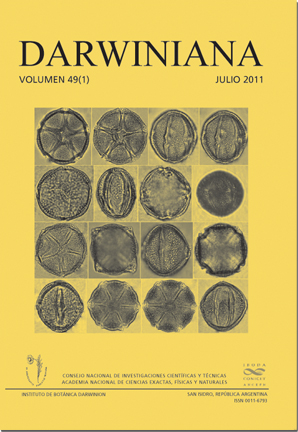Telomeric heterochromatin, seeds and meiotic characteristics in two tricepiro lines
DOI:
https://doi.org/10.14522/darwiniana.2014.491.267Keywords:
Heterochromatin, micronuclei, shriveled kernels, tricepiro, univalentsAbstract
A hybrid, named tricepiro, was obtained in 1972, by crossing a hexaploid triticale (2n=6x=42) and an octoploid trigopiro (2n=8x=56). The lines achieved include the tricepiro Don René INTA, which has shriveled kernels, and FA-L2, which has smooth ones. The relationship between the heterochromatin content of the rye chromosomes, the seed weight, the presence of meiotic abnormalities and the kernel shriveling has been documented previously in other intergeneric hybrids. The purpose of this study was to determine the average percentage of heterochromatin content in the rye chromosomes of the two tricepiro lines mentioned above and to relate this feature to some characteristics of the meiosis and seeds. We confirmed that the two lines have the same total chromosome number (2n=42) and the same number of rye chromosomes (14). We found that both lines have a complete chromosome mating until late diakinesis, but differ in the percentage of cells with univalents outside the equatorial plate in Metaphase I (Don René 42.85% and FA-L2 14.00%). In addition, the two lines differed in their meiotic index (Don René 66.47% and FA-L2 87.90%) and seed weight (Don René 0.029 ± 0.000 g and FA-L2 0.038 ± 0.001 g). The C-banding in rye chromosomes in mitotic metaphase indicated that the average percentage of heterochromatin content did not differ significantly between the two lines. Incontrast to our expectations, the meiotic behavior and seed characteristics were not related to the heterochromatin percentage of the rye chromosomes of the tricepiro lines studied.
Downloads
Published
31-07-2011
How to Cite
Fradkin, M., Greizerstein, E., Poggio, L., Paccapelo, H., & Ferrari, M. R. (2011). Telomeric heterochromatin, seeds and meiotic characteristics in two tricepiro lines. Darwiniana, Nueva Serie, 49(1), 25–31. https://doi.org/10.14522/darwiniana.2014.491.267
Issue
Section
Genetics
License

Starting on 2012, Darwiniana Nueva Serie uses Licencia Creative Commons Atribución-NoComercial 2.5 Argentina .






